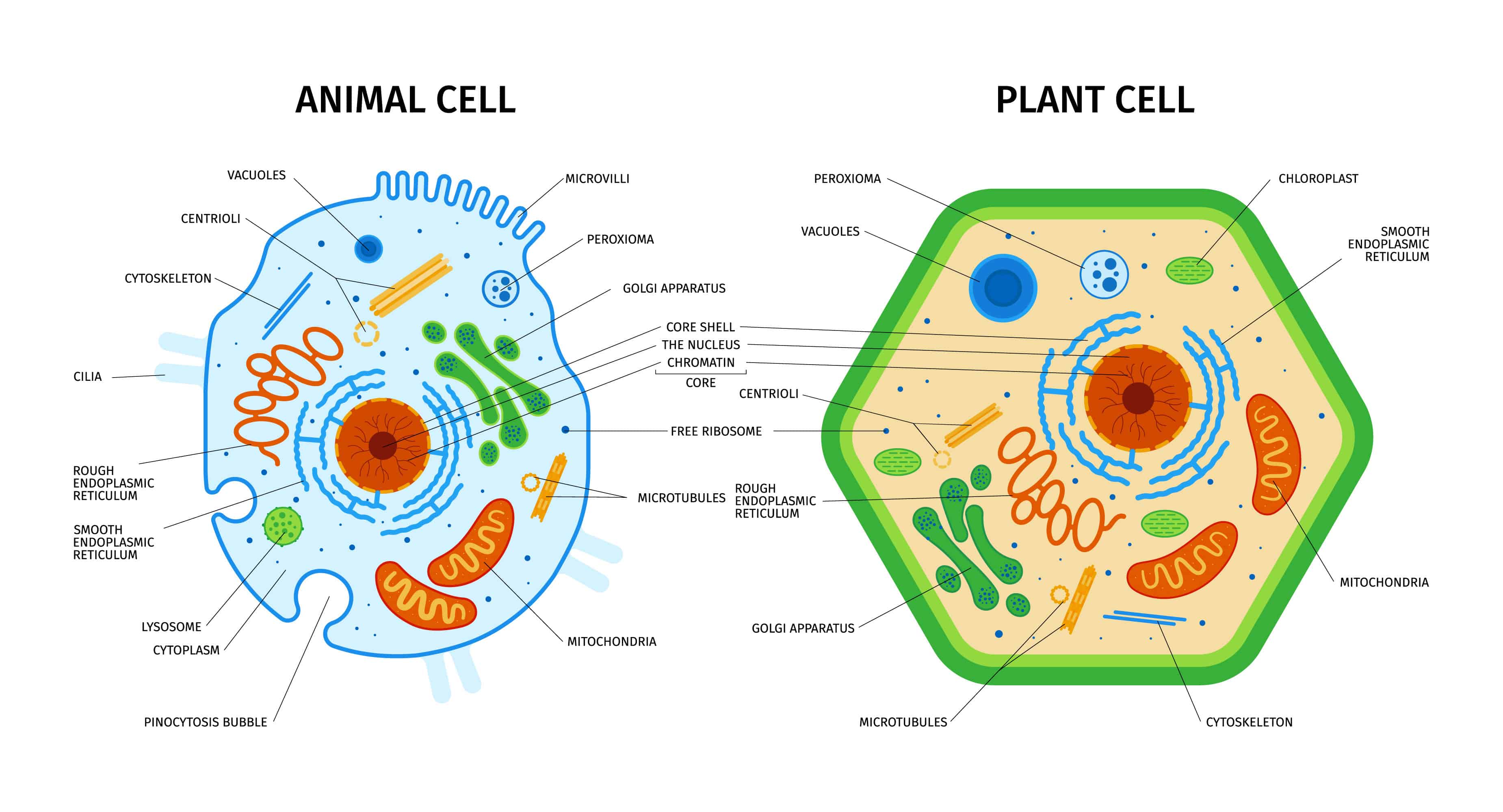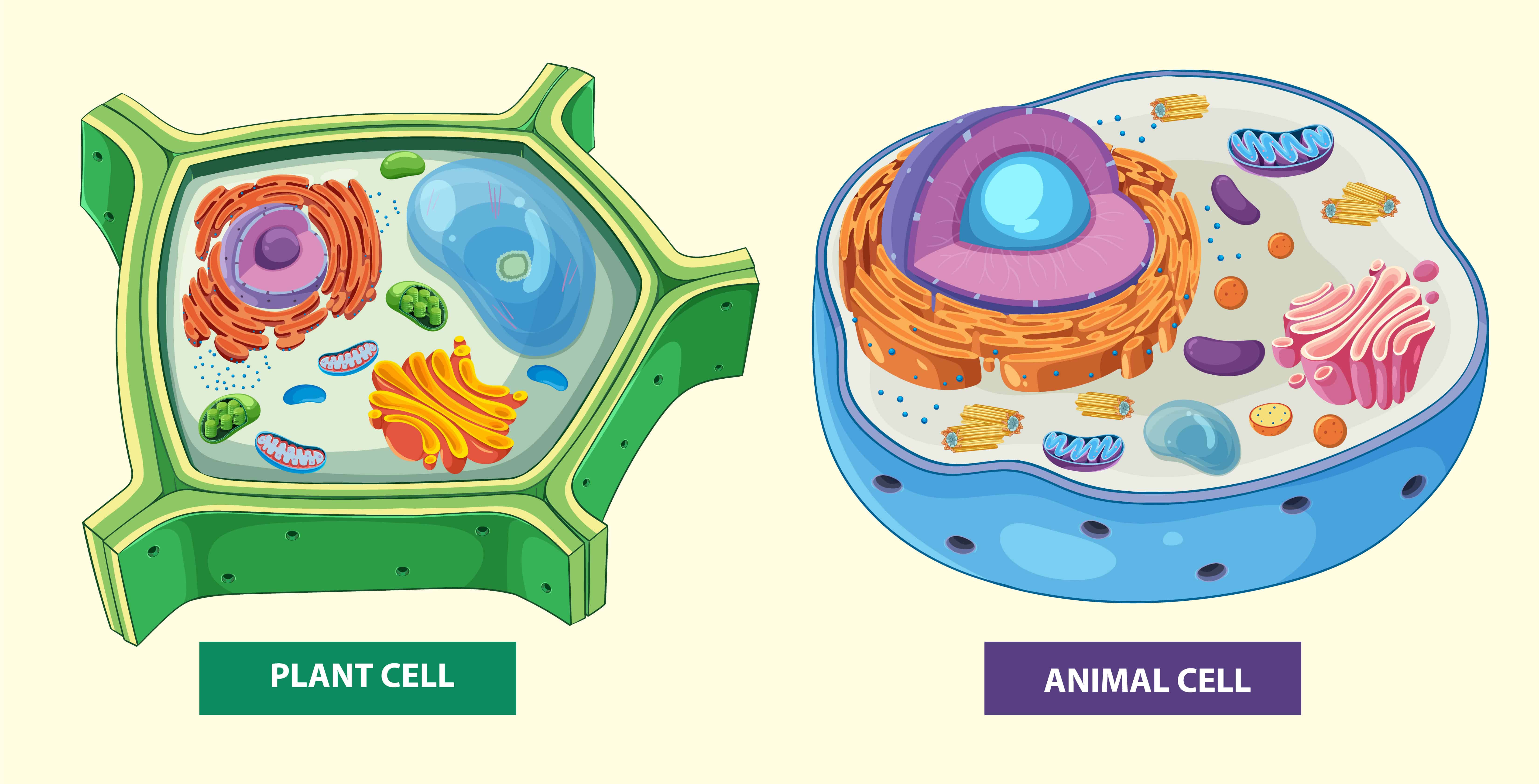A Closer Look at Cells: Plant vs. Animal
A Closer Look at Cells: Plant vs. Animal
At the end of this lesson, you are expected to:
Identify the parts and functions of the cell membrane and cytoplasm.
Describe the cell membrane as the outer boundary of the cell and the cytoplasm as the jelly-like substance that fills the cell.
Explain the basic functions of the cell membrane in protecting the cell and controlling what enters and leaves.
Explain the basic functions of the cytoplasm in holding organelles and facilitating chemical reactions.
Imagine you have a special box that holds all your most precious belongings. This box has a strong lid that you can open and close, and it keeps everything inside safe. What do you think would happen if the box had no lid, or if the lid was full of holes? Your belongings might get lost, damaged, or even stolen, right?
Cells are a lot like these special boxes! They have a boundary that keeps everything inside and protected. Today, we're going to explore this boundary and the "stuff" inside it.
Welcome, young scientists! Today, we're going to dive into the amazing world inside a cell. Remember how we learned that cells are the basic building blocks of life? Well, every cell, whether it's from a plant, an animal, or even a tiny bacterium, has a special way of keeping its important parts together and safe.

We'll be focusing on two key parts of the cell today: the cell membrane and the cytoplasm. Think of them as the cell's protective skin and its inner world.
Let's start with the cell membrane. You can think of it as the "skin" of the cell. It's like the walls and the door of a house, or the lid and sides of our special box from the warm-up activity.
What is the Cell Membrane?
The cell membrane is a very thin, flexible layer that surrounds the entire cell. It's like a delicate bag that holds all the cell's contents. It's so thin that you can't see it without a very powerful microscope, like the compound microscope we'll be learning more about soon!
What does it do? (Functions of the Cell Membrane)
The cell membrane has some super important jobs:
Protection: Its main job is to protect the cell. It acts as a barrier, keeping the inside of the cell separate from the outside environment. This is like the walls of a house protecting the people inside from the weather and anything else outside.
Control of Movement (Selective Permeability): This is where the cell membrane gets really interesting! It's not just a solid wall; it's more like a gatekeeper or a security guard. The cell membrane is selectively permeable, which means it controls what can pass into the cell and what can pass out of the cell.
What can come IN? The cell needs certain things to survive and function, like food (nutrients), water, and oxygen. The cell membrane allows these essential materials to enter.
What can go OUT? Cells also produce waste products, like carbon dioxide, that need to be removed. The cell membrane lets these waste materials exit the cell.
Think about it like this: Imagine your school gate. It's open during school hours, allowing students and teachers to enter and leave. But it's closed at night to keep the school safe. The cell membrane works similarly, but it's constantly "deciding" what goes in and out based on the cell's needs.
Real-World Example 1: A Grocery Store Think of a grocery store. The doors of the grocery store are like the cell membrane. They allow customers (nutrients, oxygen) to come in and buy what they need. They also allow people to leave with their groceries. However, the store doesn't let just anyone or anything wander in and out freely. There are rules and a system to manage who enters and exits. Similarly, the cell membrane has special "channels" and "pumps" made of proteins that help move specific substances across it.
Real-World Example 2: A Filtered Water Bottle Another example is a water bottle with a filter. The bottle itself is like the cell membrane. The filter allows water to pass through, but it blocks impurities like dirt or sand. This way, you only get clean water to drink. The cell membrane is like a very sophisticated filter for the cell, ensuring only the right things get in and out.
Structure of the Cell Membrane (A Little More Detail)
The cell membrane is mostly made up of a special type of fat called phospholipids. These phospholipids arrange themselves in a double layer, like a sandwich. This double layer creates a barrier that is good at keeping water-soluble substances out. Embedded within this phospholipid layer are also proteins. These proteins act like the "gates" and "channels" we talked about, helping to transport specific molecules across the membrane.
Now that we know about the cell's protective boundary, let's look at what's inside! The cytoplasm is everything within the cell membrane, except for the nucleus (which we'll talk about in another lesson).
What is the Cytoplasm?
The cytoplasm is a jelly-like substance that fills the cell. It's mostly made of water, but it also contains salts, sugars, proteins, and many other important molecules. Think of it as the "soup" or the "gel" that fills the cell.
What does it do? (Functions of the Cytoplasm)
The cytoplasm is a very busy place! It has several crucial functions:
Holding Organelles: The cytoplasm is like the "factory floor" where all the cell's tiny "machines," called organelles, are located. These organelles are specialized structures that perform specific jobs for the cell. Examples include mitochondria (the cell's powerhouses), ribosomes (protein builders), and in plant cells, chloroplasts (for making food). The cytoplasm suspends these organelles, keeping them in place and allowing them to function properly.
Site of Chemical Reactions: Many important chemical reactions happen in the cytoplasm. These reactions are essential for the cell's life processes, such as breaking down food for energy and building new molecules. It's like the cytoplasm is the kitchen where all the cooking and mixing happens to create the energy and materials the cell needs.
Real-World Example 1: A Busy Workshop Imagine a carpenter's workshop. The workshop itself is like the cytoplasm. It's filled with tools (organelles) like saws, hammers, and drills, all organized and ready to be used. The carpenter (the cell) uses these tools to build things. The floor of the workshop is where all the sawdust and scraps are, but it's also where the work gets done. The cytoplasm is similar; it holds the organelles and is the place where many cellular "jobs" are performed.
Real-World Example 2: A Swimming Pool Think of a swimming pool. The water in the pool is like the cytoplasm. It fills the pool and allows swimmers (organelles) to move around and do their activities. The pool also contains chemicals like chlorine that help keep the water clean and safe, similar to how the cytoplasm contains various molecules that support cellular functions.
What's the difference between Cytoplasm and Cytosol?
Sometimes you might hear the term cytosol. Cytosol is the fluid part of the cytoplasm. So, the cytoplasm includes the cytosol and all the organelles suspended within it. Think of it this way: the cytoplasm is the whole swimming pool, including the water, the swimmers, the lane ropes, and the diving board. The cytosol is just the water itself.
Plant Cells vs. Animal Cells: A Quick Look
Remember that plant cells and animal cells have some differences?
Cell Membrane: Both plant and animal cells have a cell membrane.
Cytoplasm: Both plant and animal cells have cytoplasm.
However, plant cells have a cell wall outside their cell membrane, which gives them extra support and protection. Animal cells do not have a cell wall. We'll learn more about these differences in our next lessons!
Let's test your understanding and have some fun!
Look at the simple diagram below. Can you label the cell membrane and the cytoplasm?

Answer Key:
The outer boundary is the Cell Membrane.
The jelly-like substance filling the cell is the Cytoplasm.
This is like the game "Simon Says"! I will give instructions, and you will perform an action if the instruction starts with "Cell Membrane Says." If it doesn't, you should freeze!
Cell Membrane Says: Pretend to be a gatekeeper, opening and closing your hands.
Cytoplasm: Freeze!
Cell Membrane Says: Allow a nutrient (pretend to bring a small object into your cupped hands) to enter the cell.
Cell Membrane Says: Let waste (pretend to push something out of your cupped hands) leave the cell.
Cytoplasm: Freeze!
Cell Membrane Says: Hold all the organelles (wiggle your fingers inside your cupped hands) in place.
Cytoplasm: Freeze!
Cell Membrane Says: Act as a barrier, protecting the inside.
Draw your own simple picture of a cell. Make sure to clearly show the cell membrane as the outer boundary.
Inside the cell membrane, draw and label the cytoplasm. You can draw a few simple shapes inside the cytoplasm to represent organelles.
Write one sentence describing the main job of the cell membrane.
Write one sentence describing the main job of the cytoplasm.
Understanding the cell membrane and cytoplasm is fundamental to understanding how all living things work.
Health and Medicine: When you get sick, it's often because tiny organisms like bacteria or viruses are trying to get into your cells or are releasing harmful substances. Doctors and scientists study cell membranes to understand how these invaders work and how to stop them. Medicines are often designed to target specific processes happening within the cell membrane or cytoplasm.
Food and Digestion: When you eat food, your body breaks it down into smaller pieces that can enter your cells through the cell membrane. The cytoplasm then helps process these nutrients to give you energy.
Plant Growth: Plants need to take in water and nutrients from the soil through their cell membranes. The cytoplasm in plant cells is where they make their food using sunlight (photosynthesis), which is essential for their growth.
The cell membrane is the outer boundary of the cell that protects it and controls what enters and leaves (it's selectively permeable).
The cytoplasm is the jelly-like substance filling the cell, which holds the organelles and is the site of many important chemical reactions.
The cell membrane is like a gatekeeper, and the cytoplasm is like the busy factory floor or the cell's internal environment.
Observe: Next time you see a plant or an animal, think about the tiny cells that make them up and how their cell membranes and cytoplasm are working to keep them alive.
Explain: Try explaining to a friend or family member what the cell membrane and cytoplasm do, using the examples we discussed today.
Explore: If you have a chance to use a microscope, try to observe different types of cells and imagine the cell membrane and cytoplasm within them!
No Comments Yet